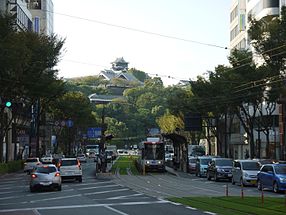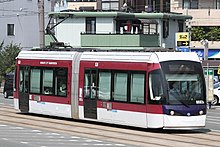Kumamoto tram
| Kumamoto tram | |
|---|---|
| Low-floor car at the Tōrichō-suji stop near the castle | |
| Basic information | |
| Country | Japan |
| city | Kumamoto |
| opening | 1924 |
| operator | Kumamoto Tourist Office |
| Infrastructure | |
| Route length | 12.2 km |
| Formerly the largest route |
approx. 30 km |
| Gauge | 1435 mm ( standard gauge ) |
| Power system | 600 V = overhead line |
| business | |
| Lines | 2 |
The Kumamoto tram ( Japanese 熊 本市 電 , Kumamoto shiden ) is a tram network in Kumamoto on the island of Kyūshū in Japan .
It consists of two lines that run over a common trunk line from the eastern districts to the center, where they branch off. Line A continues to the southwest to the main train station, line B to the north to the upper station ( 上 熊 本 駅 Kami-Kumamoto-eki ).
The electric tram opened in 1924, and operation has been under city management from the very beginning.
Previously existing on-site steam trams were only partially integrated later after electrification and re-gauging (s). The network experienced its greatest expansion around 1960, when it covered large parts of the urban area with about 30 km as well as to the southern town of Kawashiri ( 川 尻 ) and via a separate line with 1067 mm gauge to the west of Hyakkanseki ( 百 貫 石 ) was enough. Since then, numerous routes have been closed, so that the current network remained.
Potential expansions have not progressed beyond the discussion stage since then.
A total of 45 vehicles are used. The fleet consists mostly of high-floor single wagons. From 1997, low-floor articulated railcars were first put into operation in Japan; MAN / Adtranz supplied five two-part models for this. Since 2009 three similar vehicles from Niigata-Transys have also been added.
Web links
- Official Japanese Website (Japanese)
Remarks
- ↑ The preparatory company was already taken over by the city before commissioning
- ↑ Current newspaper article (September 2016) on planned network expansions



